warning CITROEN C5 AIRCROSS 2020 Handbook (in English)
[x] Cancel search | Manufacturer: CITROEN, Model Year: 2020, Model line: C5 AIRCROSS, Model: CITROEN C5 AIRCROSS 2020Pages: 292, PDF Size: 8.59 MB
Page 157 of 292

155
70
70
Indicator lamp in
the buttonSymbol
Cruise control wheel DisplayAssociated
messageComments
Green
(grey colour) "OFF"
-"Activate the cruise
control to use the Lane Keeping
Assist function" All operating conditions are met except
activation of the adaptive cruise control.
Green (grey colour) "CRUISE"
or
(green colour) "Unsuitable
conditions –
Activation on stand-by" All conditions required for lateral
control have not been met.
Off -"CRUISE"
or
(green colour) "Hold the wheel" The driver is not holding the steering
wheel correctly and has not taken
notice of the warnings (messages
and audible alarm): the Active Lane
Keeping Assist function is switched off.
Green (grey colour) "CRUISE"
or
(grey colour) "Retake control"
The cruise control can no longer
ensure lateral and longitudinal control:
the driver must retake control of the
vehicle (acceleration or braking). The
alert is accompanied by an audible
signal.
6
Driving
Page 158 of 292

156
Operating limits
The Active Lane Keeping Assist system
may issue an alert when the vehicle
is travelling in a long straight lane on
a
smooth road sur face even if the driver is
holding the steering wheel properly.
The system may fail to operate or may produce
unsuitable corrections to the steering in the
following situations:
-
P
oor visibility (insufficient road lighting,
snowfall, rain, fog).
-
D
azzle (headlamps of an oncoming vehicle,
low sun, reflections on a
wet road sur face,
leaving a
tunnel, alternating light and
shade).
-
W
indscreen area in front of the camera
being dirty, misted up, frost-covered, snow-
covered, damaged or masked by a
sticker.
-
L
ane markings eroded, partially hidden
(snow, mud) or multiple (roadworks, sur face
j o i nt s).
-
T
ravelling in a tight bend.
-
W
inding roads.
-
P
resence of a tarmac joint on the road. The system must not be activated in the
following situations:
-
D riving with a "space-saver" type
spare wheel.
-
W
hen towing, especially with an
unconnected or unapproved trailer.
-
P
oor weather conditions.
-
D
riving on slippery road sur faces (risk
of aquaplaning, snow, ice).
-
D
riving on racing circuits.
-
D
riving on a rolling road.
Recommendations on care
- Regularly check that the front bumper and the area of the windscreen located in front
of the camera are clean.
-
R
egularly check that the windscreen wipers
are in good condition.
-
I
n bad weather, or during the winter, ensure
that the front bumper and windscreen are
not covered with mud, ice or snow.
Malfunctions
(orange
colour) A system malfunction is indicated
by the Ser vice warning lamp
coming on and this (orange) symbol,
accompanied by an alert message
and an audible signal.
Active Safety Brake with
Collision Risk Alert and
Intelligent emergency
braking assistance
Refer to the General recommendations on
the use of driving and manoeuvring aids
.
This system allows:
-
t
he driver to be warned that their vehicle is
at risk of collision with the vehicle in front,
a pedestrian or, depending on version, a
cyclist,
-
a c
ollision to be prevented, or its severity to
be limited, by reducing the vehicle's speed.
Driving
Page 159 of 292

157
The system also takes motorcyclists and
animals into account; however, animals
below 0.5 m tall and objects on the road
are not necessarily detected.
This system is comprised of three functions:
-
C
ollision Risk Alert,
-
I
ntelligent emergency braking assistance,
-
A
ctive Safety Brake (automatic emergency
b r ak ing).
The vehicle has a
multifunctional camera
located at the top of the windscreen, and,
depending on version, a radar located in the
front bumper. As soon as the system detects a
potential
obstacle, it prepares the braking circuit in
case automatic braking is needed. This
may cause a
slight noise and a slight
sensation of deceleration.
Deactivation/Activation
By default, the system is automatically
activated at every engine start.
This system can be deactivated or
activated via the Driving /Vehicle
menu of the touch screen.
Deactivation of the system is
signalled by the illumination of this
indicator lamp, accompanied by the
display of a
message.
Operating conditions and
limits
The ESC system must not be faulty.
The DSC/ASR systems must not be
deactivated.
All passenger seat belts must be fastened.
Driving at a steady speed on roads with few
bends is required. In the following cases, deactivating the system
via the vehicle's configuration menu is advised:
-
t
owing a trailer,
-
c
arrying long objects on roof bars or roof
rack,
-
w
ith snow chains fitted,
-
b
efore using an automatic car wash, with
the engine running,
-
b
efore placing the vehicle on a rolling road
in a workshop,
-
t
owed vehicle, engine running,
-
d
amaged front bumper (version with radar),
-
f
ollowing an impact to the windscreen close
to the detection camera.
The system is automatically deactivated
after the use of certain "space-saver"
type spare wheels is detected (smaller
diameter).
The system is automatically deactivated
after detection of a fault with the brake
pedal switch or with at least two brake
lamps.
It is possible that warnings are not given,
are given too late or seem unjustified.
Consequently, always stay in control of
your vehicle and be prepared to react at
any time to avoid an accident.
6
Driving
Page 160 of 292
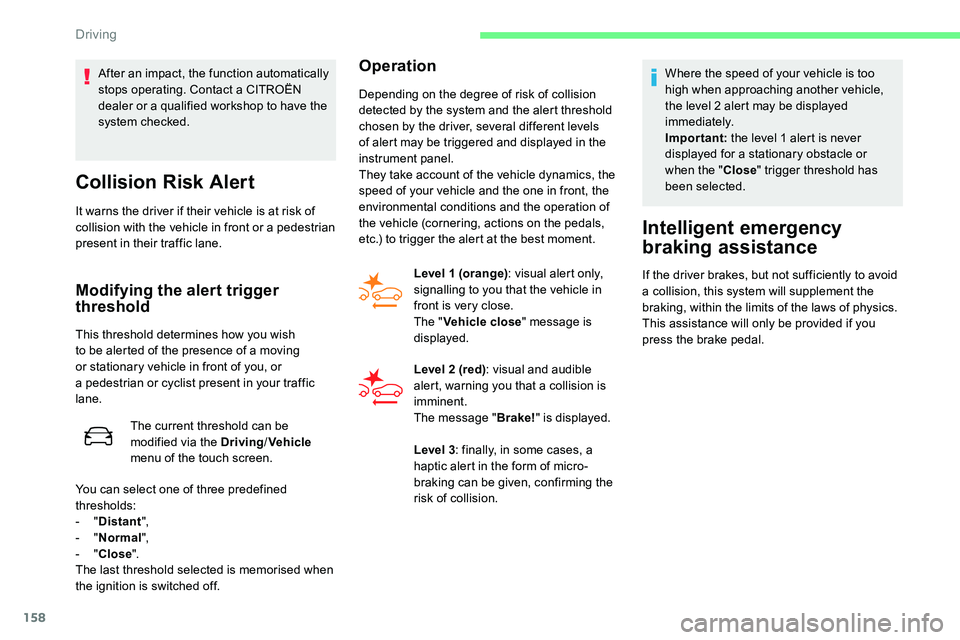
158
Collision Risk Alert
It warns the driver if their vehicle is at risk of
collision with the vehicle in front or a pedestrian
present in their traffic lane.
Modifying the alert trigger
threshold
This threshold determines how you wish
to be alerted of the presence of a moving
or stationary vehicle in front of you, or
a
pedestrian or cyclist present in your traffic
lane.
The current threshold can be
modified via the Driving /Vehicle
menu of the touch screen.
You can select one of three predefined
thresholds:
-
"Distant ",
-
"Normal ",
-
"Close ".
The last threshold selected is memorised when
the ignition is switched off.
Operation
Depending on the degree of risk of collision
detected by the system and the alert threshold
chosen by the driver, several different levels
of alert may be triggered and displayed in the
instrument panel.
They take account of the vehicle dynamics, the
speed of your vehicle and the one in front, the
environmental conditions and the operation of
the vehicle (cornering, actions on the pedals,
etc.) to trigger the alert at the best moment.
Level 1 (orange) : visual alert only,
signalling to you that the vehicle in
front is very close.
The " Vehicle close " message is
displayed.
Level 2 (red) : visual and audible
alert, warning you that a
collision is
imminent.
The message " Brake!" is displayed.
Level 3 : finally, in some cases, a
haptic alert in the form of micro-
braking can be given, confirming the
risk of collision. Where the speed of your vehicle is too
high when approaching another vehicle,
the level 2
alert may be displayed
immediately.
Important: the level 1
alert is never
displayed for a
stationary obstacle or
when the " Close" trigger threshold has
been selected.
Intelligent emergency
braking assistance
If the driver brakes, but not sufficiently to avoid
a collision, this system will supplement the
braking, within the limits of the laws of physics.
This assistance will only be provided if you
press the brake pedal.
After an impact, the function automatically
stops operating. Contact a
CITROËN
dealer or a
qualified workshop to have the
system checked.
Driving
Page 161 of 292
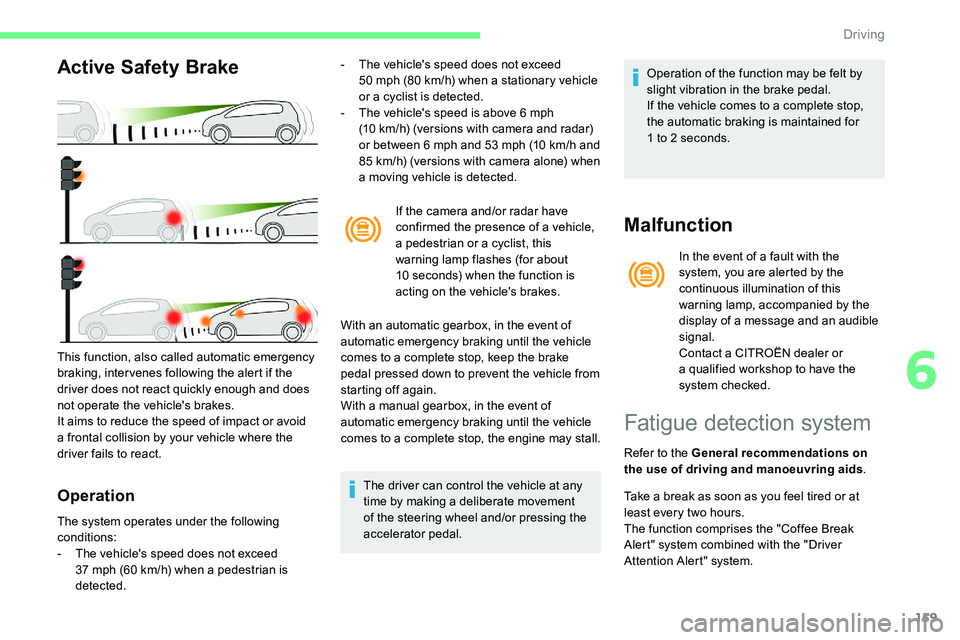
159
Active Safety Brake
Operation
- The vehicle's speed does not exceed 50 mph (80 km/h) when a stationary vehicle
or a
cyclist is detected.
-
T
he vehicle's speed is above 6 mph
(10
km/h) (versions with camera and radar)
or between 6
mph and 53 mph (10 km/h and
85
km/h) (versions with camera alone) when
a
moving vehicle is detected.If the camera and/or radar have
confirmed the presence of a
vehicle,
a pedestrian or a
cyclist, this
warning lamp flashes (for about
10
seconds) when the function is
acting on the vehicle's brakes.
With an automatic gearbox, in the event of
automatic emergency braking until the vehicle
comes to a
complete stop, keep the brake
pedal pressed down to prevent the vehicle from
starting off again.
With a
manual gearbox, in the event of
automatic emergency braking until the vehicle
comes to a
complete stop, the engine may stall.
The driver can control the vehicle at any
time by making a
deliberate movement
of the steering wheel and/or pressing the
accelerator pedal. Operation of the function may be felt by
slight vibration in the brake pedal.
If the vehicle comes to a
complete stop,
the automatic braking is maintained for
1
to 2 seconds.
Malfunction
In the event of a fault with the
s ystem, you are alerted by the
continuous illumination of this
warning lamp, accompanied by the
display of a
message and an audible
signal.
Contact a
CITROËN dealer or
a
qualified workshop to have the
system checked.
This function, also called automatic emergency
braking, inter venes following the alert if the
driver does not react quickly enough and does
not operate the vehicle's brakes.
It aims to reduce the speed of impact or avoid
a
frontal collision by your vehicle where the
driver fails to react.
The system operates under the following
conditions:
-
T
he vehicle's speed does not exceed
37
mph (60
km/h) when a
pedestrian is
detected.
Fatigue detection system
Refer to the General recommendations on
the use of driving and manoeuvring aids .
Take a
break as soon as you feel tired or at
least every two hours.
The function comprises the "Coffee Break
Alert" system combined with the "Driver
Attention Alert" system.
6
Driving
Page 163 of 292
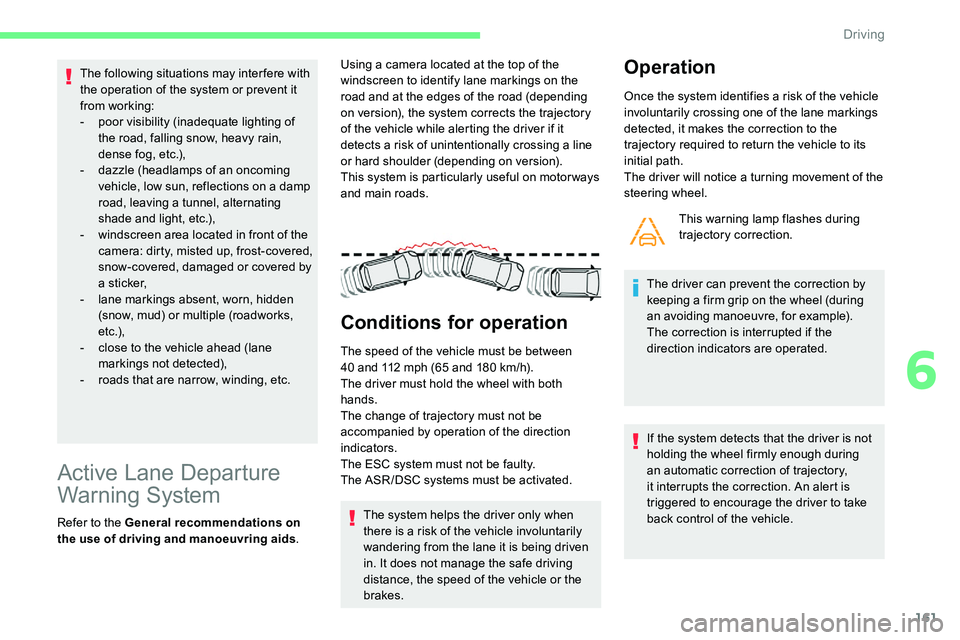
161
The following situations may interfere with
the operation of the system or prevent it
from working:
-
p
oor visibility (inadequate lighting of
the road, falling snow, heavy rain,
dense fog, etc.),
-
d
azzle (headlamps of an oncoming
vehicle, low sun, reflections on a
damp
road, leaving a
tunnel, alternating
shade and light, etc.),
-
w
indscreen area located in front of the
camera: dirty, misted up, frost-covered,
snow-covered, damaged or covered by
a
s t i c ke r,
-
l
ane markings absent, worn, hidden
(snow, mud) or multiple (roadworks,
e t c .),
-
c
lose to the vehicle ahead (lane
markings not detected),
-
r
oads that are narrow, winding, etc.
Active Lane Departure
Warning System
Refer to the General recommendations on
the use of driving and manoeuvring aids .Using a
camera located at the top of the
windscreen to identify lane markings on the
road and at the edges of the road (depending
on version), the system corrects the trajectory
of the vehicle while alerting the driver if it
detects a risk of unintentionally crossing a line
or hard shoulder (depending on version).
This system is particularly useful on motor ways
and main roads.
Conditions for operation
The speed of the vehicle must be between
40 and 112 mph (65 and 180 km/h).
The driver must hold the wheel with both
hands.
The change of trajectory must not be
accompanied by operation of the direction
indicators.
The ESC system must not be faulty.
The ASR /DSC systems must be activated.
The system helps the driver only when
there is a
risk of the vehicle involuntarily
wandering from the lane it is being driven
in. It does not manage the safe driving
distance, the speed of the vehicle or the
brakes.
Operation
Once the system identifies a risk of the vehicle
i nvoluntarily crossing one of the lane markings
detected, it makes the correction to the
trajectory required to return the vehicle to its
initial path.
The driver will notice a
turning movement of the
steering wheel.
This warning lamp flashes during
trajectory correction.
The driver can prevent the correction by
keeping a
firm grip on the wheel (during
an avoiding manoeuvre, for example).
The correction is interrupted if the
direction indicators are operated.
If the system detects that the driver is not
holding the wheel firmly enough during
an automatic correction of trajectory,
it interrupts the correction. An alert is
triggered to encourage the driver to take
back control of the vehicle.
6
Driving
Page 166 of 292

164
The following situations may interfere with
the operation of the system or prevent it
from working:
-
c
onditions of poor visibility (inadequate
street lighting, snowfall, rain, fog),
-
d
azzle (headlamps of an oncoming
vehicle, low sun, reflections on a
damp
road, leaving a
tunnel, alternating
shade and light),
-
w
indscreen area located in front of the
camera: dirty, misted, frost-covered,
snow-covered, damaged or covered by
a
s t i c ke r,
-
l
ane markings worn, hidden (snow,
mud) or multiple (roadworks, etc.),
-
r
unning close to the vehicle in front
(the lane markings may not be
detected),
-
r
oads that are narrow, winding,
-
i
nsufficient contrast (shade, for
example) between the road and the
edges of the road.
Risk of undesirable operation
Deactivation of the system is recommended in
the following situations:
-
d
riving on a road sur face in poor condition,
-
u
nfavourable climatic conditions,
-
d
riving on slippery sur faces (ice).
Deactivation/Activation
The system is activated every time the ignition
is switched on.
F
T
o deactivate the system, press this button. Deactivation is signalled by the
lighting of the indicator lamp in
the button and this warning lamp on
the instrument panel.
Reactivation is by another press, the indicator
lamp in the button and the warning lamp switch
of f.
MalfunctionThe system is not intended for driving in the
following situations:
-
d
riving on a speed circuit,
-
d
riving with a trailer,
-
d
riving on a rolling stand,
-
d
riving on unstable sur faces. In the event of a
fault with the system, you are
alerted by the illumination of these warning
lamps in the instrument panel, accompanied by
the display of a
message and an audible signal.
Have the system checked by a
CITROËN
dealer or a
qualified workshop.
Active Blind Spot
Monitoring System
Refer to the General recommendations on
the use of driving and manoeuvring aids.
Driving
Page 167 of 292

165
This system warns the driver of the presence
of another vehicle in the blind spots of their
vehicle (areas hidden from the driver's field
of vision), as soon as this presents a potential
danger.
A fixed warning lamp appears in the door mirror
on the side in question:
-
i
mmediately, when being overtaken,
-
a
fter a delay of about one second, when
overtaking a
vehicle slowly.
In addition to the fixed warning lamp in the door
mirror on the side in question, a correction of
trajectory will be felt if you attempt to cross
a
lane marking with the direction indicator
activated, to help you avoid a
collision.This driving aid system is designed to
improve safety when driving and is in no
circumstances a
substitute for the use
of the interior rear view mirror and door
mirrors. It is the driver's responsibility to
constantly check the traffic, to assess the
relative distances and speeds of other
vehicles and to anticipate their movements
before deciding whether to change lane.
Activation/Deactivation
The function is activated and
deactivated in the Driving/Vehicle
menu of the touch screen.
The state of the system stays in the memory
when switching off the ignition.
The system is automatically deactivated
when towing with a
towing device
approved by CITROËN.
Operation
The alert is given by an orange warning lamp
coming on in the relevant door mirror, as soon
as a
vehicle – car, lorry, bicycle – is detected.
A correction of trajectory will be felt if you
attempt to cross a
lane marking with the
direction indicator flashing.
The following conditions must be met for this:
-
a
ll vehicles are moving in the same direction
and in adjacent lanes,
-
t
he speed of the vehicle must be between
7
and 87 mph (12 and 140 km/h) for the
alert and between 40
and 87 mph (65 and
140
km/h) for a correction of trajectory,
-
t
he system must be activated to trigger
a
change of trajectory,
-
y
ou overtake a vehicle with a speed
difference of less than 6
mph (10 km/h),
-
a v
ehicle overtakes you with a speed
difference of less than 16
mph (25 km/h),
-
t
he traffic is flowing normally,
-
ov
ertaking a vehicle over a certain period
of time and the vehicle being overtaken
remains in the blind spot,
-
y
ou are driving on a straight or slightly
curved road,
-
y
our vehicle is not towing a trailer, a
caravan, etc.
Sensors fitted in the front and rear bumpers
monitor the blind spots.
6
Driving
Page 168 of 292
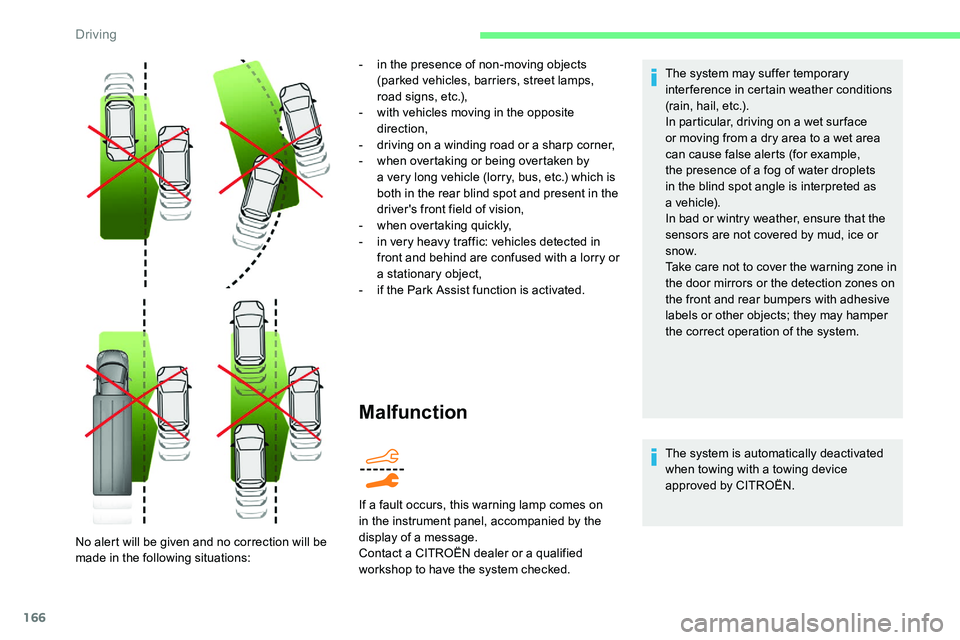
166
Malfunction
The system may suffer temporary
interference in certain weather conditions
(rain, hail, etc.).
In particular, driving on a wet sur face
or moving from a
dry area to a wet area
can cause false alerts (for example,
the presence of a
fog of water droplets
in the blind spot angle is interpreted as
a
vehicle).
In bad or wintry weather, ensure that the
sensors are not covered by mud, ice or
snow.
Take care not to cover the warning zone in
the door mirrors or the detection zones on
the front and rear bumpers with adhesive
labels or other objects; they may hamper
the correct operation of the system.
The system is automatically deactivated
when towing with a
towing device
approved by CITROËN.
If a
fault occurs, this warning lamp comes on
in the instrument panel, accompanied by the
display of a
message.
Contact a
CITROËN dealer or a
qualified
workshop to have the system checked.
No alert will be given and no correction will be
made in the following situations: -
i
n the presence of non-moving objects
(parked vehicles, barriers, street lamps,
road signs, etc.),
-
w
ith vehicles moving in the opposite
direction,
-
d
riving on a
winding road or a
sharp corner,
-
w
hen overtaking or being overtaken by
a
very long vehicle (lorry, bus, etc.) which is
both in the rear blind spot and present in the
driver's front field of vision,
-
w
hen overtaking quickly,
-
i
n very heavy traffic: vehicles detected in
front and behind are confused with a
lorry or
a
stationary object,
-
i
f the Park Assist function is activated.
Driving
Page 170 of 292
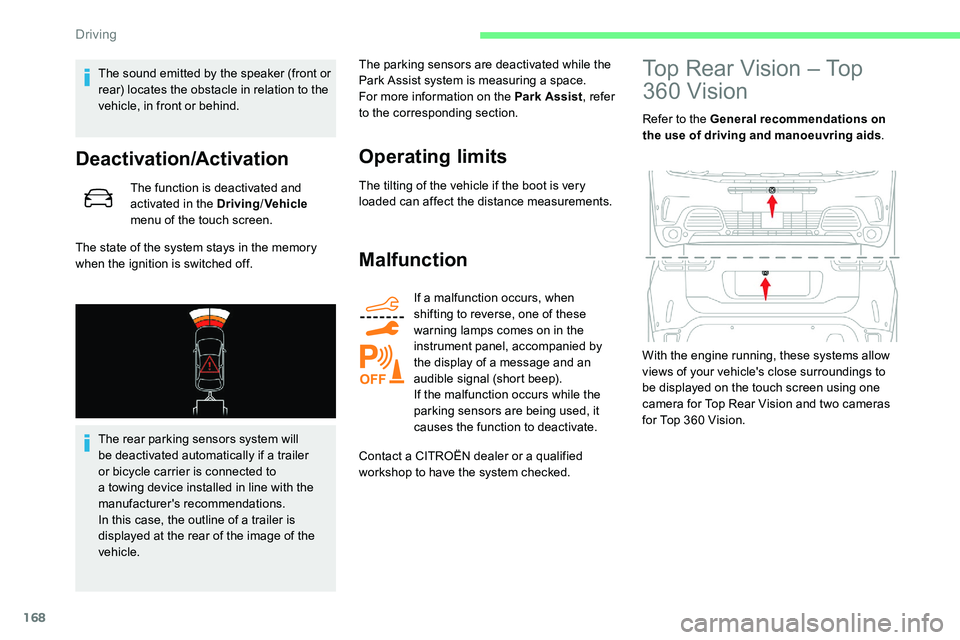
168
The sound emitted by the speaker (front or
rear) locates the obstacle in relation to the
vehicle, in front or behind.
Deactivation/Activation
The function is deactivated and
activated in the Driving/Vehicle
menu of the touch screen.
The state of the system stays in the memory
when the ignition is switched off.
The rear parking sensors system will
be deactivated automatically if a
trailer
or bicycle carrier is connected to
a
towing device installed in line with the
manufacturer's recommendations.
In this case, the outline of a
trailer is
displayed at the rear of the image of the
vehicle. The parking sensors are deactivated while the
Park Assist system is measuring a
space.
For more information on the Park Assist , refer
to the corresponding section.
Operating limits
The tilting of the vehicle if the boot is very
loaded can affect the distance measurements.
Malfunction
If a malfunction occurs, when
s hifting to reverse, one of these
warning lamps comes on in the
instrument panel, accompanied by
the display of a
message and an
audible signal (short beep).
If the malfunction occurs while the
parking sensors are being used, it
causes the function to deactivate.
Contact a
CITROËN dealer or a qualified
workshop to have the system checked.
Top Rear Vision – Top
360
Vision
Refer to the General recommendations on
the use of driving and manoeuvring aids .
With the engine running, these systems allow
views of your vehicle's close surroundings to
be displayed on the touch screen using one
camera for Top Rear Vision and two cameras
for Top 360
Vision.
Driving